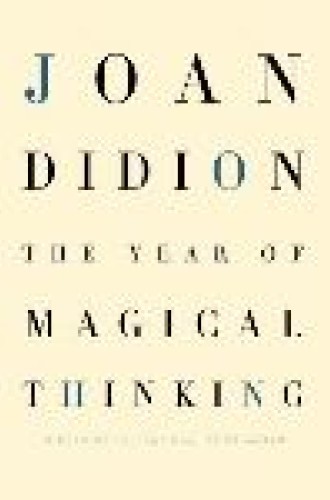The Year of Magical Thinking
In this award-winning memoir, Joan Didion, a premier observer of contemporary life, witnesses death. It walks into her New York apartment on December 30, 2003, approaches the dinner table and claims her husband of 40 years, John Gregory Dunne, who falls dead of a heart attack. Didion presents with dry clarity what happens in the year after that. Not reason, not acceptance, just observation, a reporter’s stance that looks like detachment, making the new widow seem a cool customer at the hospital where Dunne has been pronounced dead.
“Life changes fast,” Didion writes in the book’s opening sentence, but her life had already begun speeding toward change. A few days before her husband’s sudden death, their daughter, suffering pneumonia and septic shock, had been hospitalized. One family member is dead, another on life support.
Didion is precise in her observations as she circles back again and again to December 30, adding layers of detail and memory. But she is watching herself too, and charting her grief. Grief is madness, she insists, a derangement documented by Freud and others. She cites imaginative, sociological and medical literature as she works her way toward assigning or discovering meaning in the event that inaugurated a new year, a year of magical thinking. Didion reports her behavior during mourning: dining only on dishware with a pattern of sentimental significance, avoiding certain driving routes too fraught with memories, reinterpreting past events as signs and premonitions, fleeing Boston and a writing assignment.
Didion once said that she writes to find out what she thinks. “This is my attempt to make sense of the period that followed,” she announces near the beginning of her book. And she said in a recent magazine interview that she wrote the book quickly. This is also a case, however, in which writing and words are inadequate even for the most skillful of writers. “I need more than words to find the meaning,” she writes.
She also needs more than knowledge. All the medical knowledge that Didion acquires in the months following her husband’s heart attack cannot change the fact of his death. But that knowledge is an anodyne that frees her from the burden of “if only”—wondering whether if only she had done something, what ultimately happened would have been different. Like a detective, she picks at memories for clues that, in retrospect, become a foreshadowing of the end, and as her understanding grows, the massive heart attack slowly begins to seem more and more expected. A doctor’s comment on Dunne’s 1987 angiogram becomes one of the book’s several refrains: “We call it the widow maker, pal.” And so a cardiac anomaly discovered in 1987 assumes meaning 16 years later, when its message is seen to be prophetic.
When the necessity of death is accepted, then the small psychosis that is grief can be resolved. Grief never goes away, but its acuity wanes and sanity returns.
The book’s literary quality has won it awards and nominations as well as a berth on best-seller lists. Events, quotes, references return repeatedly, knitting the narrative together. The literature Didion cites in her quest for knowledge and meaning is vast and varied, from the medieval Song of Roland to the New England Journal of Medicine. Didion’s experience is uniquely hers, but all will have the opportunity to read the centuries-old literature of grief.
Didion writes in one of her reflective refrains that no eye is on the sparrow. But for a believer, the eye is on the sparrow, watching with compassion as it falls.





